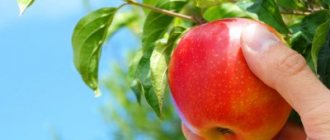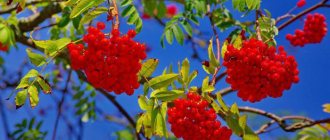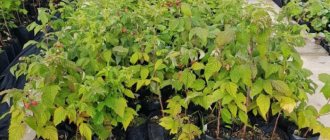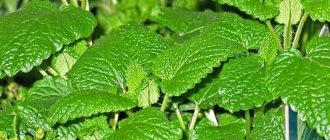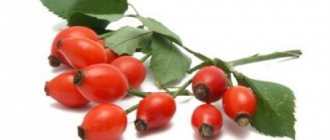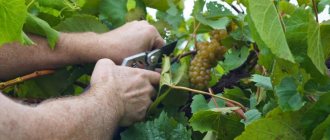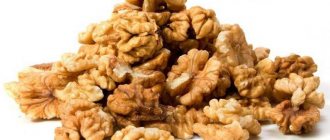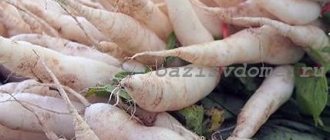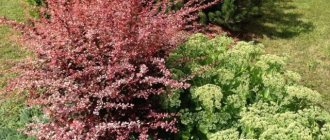Useful properties and medicinal effects of berries
The healing properties have been known since the times of Ancient Greece. For the treatment and prevention of diseases of the liver, kidneys, and bile ducts, a tincture of barberry leaves is used. It acts as a choleretic and anti-inflammatory agent. The bark, as well as roots and leaves, of the shrub contain 11 alkaloids, in particular berberine, which helps reduce heart rate and lower blood pressure.
They make a tincture that helps with bleeding, inflammation and colds and even fever. For gastritis, take a drink made from barberry berries; their juice has an antimicrobial and antipyretic effect.
The fruits are used to remove toxins and generally cleanse the body; they help slow down the aging process.
Alcohol tincture of barberry is sold in pharmacies; doctors recommend it for hepatitis, uterine bleeding and cholelithiasis. The drug Berberine is also produced on its basis. In cosmetology, it is used in the form of decoctions and various tinctures, as well as for making masks. Barberry is widely used in cooking, in particular, it is an integral ingredient for preparing Uzbek pilaf. Liqueurs, candies, wines, jams, preserves, jellies, lemonades, syrups and various seasonings are also prepared from its berries.
What can be used
Barberry berries are included in diets for weight loss, consumed to strengthen the immune system, and added in pickled form to fried or stewed vegetables. The fruits are used to make masks that smooth out wrinkles on the skin and remove dark circles under the eyes. Decoctions are prepared from leaves rich in ascorbic acid and carotene, which promote:
- stopping bleeding;
- eliminating nausea;
- excretion of bile.
The roots of barberry are dried and put into tea, and the infusion is used to rinse the mouth to relieve inflammation. The decoction is used for stomach cramps. Natural paint is obtained from the branches and trunk of barberry. Medicines from the bark of the bush reduce blood pressure and stop internal bleeding.
Existing contraindications
It is necessary to collect only ripe berries that are red or reddish-brown in color. Unripe barberry berries are poisonous. It has the property of stimulating muscle activity, so it is prohibited to use it during pregnancy - there is a risk of miscarriage. Its use is not recommended during lactation.
In addition, the berries have a strong sedative (calming) effect. Consumption of large quantities of fruits or medicines based on it leads to poisoning, severe dizziness and nausea, swelling, cramps and nosebleeds. It is prohibited to take berries and barberry-based medicines for liver cirrhosis.
Chemical composition of berries
The relatively small barberry berry contains a great variety of chemical elements important for the human body. Thanks to this, barberry is considered one of the leaders among medicinal plants.
Barberry berries contain the following substances:
- ascorbic acid (vitamin C);
- vitamins E, K;
- tannins;
- organic acids (tartaric, malic, citric);
- pectins;
- carotenoids (lutein, xanthophyll, chrysanthemumaxanthin, auroxanthin, flavoxanthin, capsanthin);
- alkaloids (berberine, oxyacanthin, columbamine, palmatine, etc.);
- ash;
- small amount of carbohydrates.
The calorie content of freshly picked barberry is about 30 kcal per 100 grams, dried - a little more than 150 kcal per 100 grams.
When to collect barberry
Fruits should be picked only when they are ripe - green berries can cause poisoning. Harvesting times depend on the growing area and variety.
See also
Characteristics and description of Patriot blueberries, planting and care
Read
Depending on the region of growth
In the middle zone, barberry collection begins in the third ten days of August, beginning of September. In the southern regions, harvesting begins in the first half of August. Barberries are harvested even after the first frost, they only benefit in taste. The berries may well sag even until mid-January-early February without significant loss of their qualities.
Depending on the variety
The timing of fruit ripening depends on the type and variety. In the conditions of the Middle Zone, different species begin to ripen from the end of August, beginning of November.
Signs of fruit ripeness
The berries are picked red and pinkish-red, preferably firm and elastic. Overripe fruits have a dark red color, they are soft, easily wrinkled and quickly turn into mush.
It is important to know that the Thunberg barberry, a popular species among summer residents and landscape designers, is not eaten. The fruits are edible, but bland - they have no taste, no signature sourness for which they are so loved.
Among edible species, the greatest varietal diversity is found in common barberry:
- Lutea;
- Asperma;
- Dulcis;
- Atropurpurea.
Amur, Canadian and spherical barberries also have edible fruits.
Collection rules
Barberry must be collected quite carefully - the sharp thorns that cover the branches can seriously prick your hands.
Manually
Harvesting barberry is not an easy task. And all thanks to the thick, rather prickly branches, through which it is sometimes difficult to get to the berries without scratching your hands. For convenience and protection of hands, wear ordinary household gloves, with 1 phalanx cut off on the fingers. The fruits are placed in small baskets or boxes.
Ripe berries come off without any extra effort and can be picked in whole bunches at once.
Using special devices
For ease of picking, small baskets are used that are hung around the neck; picked berries are placed in them. It is effective to use a small rake, which is used to push the thorny branches apart and tear off the fruits with your free hand.
Harvesting methods
To preserve barberry berries for a long period of time, various methods are used, such as processing, drying and freezing.
Drying
This is the most common method of harvesting barberry. The fruits are collected in late autumn, when they contain the highest content of nutrients. Pre-washed berries must be dried. They are allowed to weather, the moisture to evaporate, laid out in a thin layer on baking sheets and placed in the oven.
An electric dryer can also be used successfully. Drying is carried out in two stages, first at a temperature of +45...+50 C degrees, and then the temperature is increased to +60 C degrees. The berries are ready when they do not stick together when squeezed in your fist. Store barberries in glass, hermetically sealed jars. If all conditions are met, it can easily be preserved for two years.
See also
Rules for planting and caring for blueberries in the Moscow region, the best varieties
Read
Freezing
This is another effective way to store barberries. The berries are washed, dried, portioned into small bags or containers and placed in the freezer. So the fruits can be stored for more than a year.
Making jelly
A beautiful and tasty jelly is prepared from the berries using water, sugar, the fruit itself and a little gelatin. It can be consumed immediately, fresh, or rolled into jars.
Jam
Jam made from berries has not only high taste, but also healing properties. The recipe contains proportions that allow you to make jam even from a small amount of berries.
To prepare it you need:
- carefully sort through the berries, discarding all rotten and spoiled ones;
- pour the fruits (200 grams) with water and let stand for 6-7 hours;
- add 200 grams of sugar to 200 milliliters of water and boil a medium-thick syrup;
- put the barberry in the syrup and cook until it becomes transparent and the berries sink to the bottom;
- add a pinch of vanillin to the prepared jam and roll it into sterilized jars.
Popular folk recipes based on barberry
Only a properly prepared medicinal product, prepared in accordance with the dosage, will allow you to obtain the maximum therapeutic effect:
- for bronchitis, chronic cough, pneumonia and colds, you need to pour a tablespoon of fruit into a glass of water and boil for a quarter of an hour. The resulting decoction is filtered and diluted with boiled water at room temperature in a one to one ratio. You need to take 50 ml of the decoction. three times a day;
- To get rid of attacks of nausea, diarrhea and stomach cramps, a decoction of the leaves is used. For this purpose, you need to pour 30 g of plant material with a couple of glasses of boiled water and boil for a quarter of an hour. The resulting medicinal decoction is filtered through cheesecloth and diluted with boiled water in a one-to-one ratio. You need to take a tablespoon every six hours;
- To eliminate inflammatory processes in the mucous membrane of the mouth or gums, it is recommended to prepare a decoction of the root. A tablespoon of crushed root should be poured with a couple of glasses of water and boiled for a couple of minutes, then left for half an hour and strained. Add to rinse water.
It is very important to use only high-quality and properly collected plant materials. It is also important to follow the technology for preparing folk remedies and take them correctly. Before using barberry for medicinal purposes, you must consult a doctor.
When to collect and how to store other useful parts of the plant
To preserve the beneficial and medicinal properties of barberry, all parts of the plant must be harvested at their specific time.
Bark
For medicinal purposes, the bark is harvested in early spring. Before storing it, it is well dried in the shade.
Roots
The roots are dug up at the end of autumn, in the northern regions - even earlier, when the barberry is already at rest. The procedure is carried out until the soil freezes. In barberry you can dig out up to a third of the roots. Damaged, rotten places are cut out and sent to dry, without rinsing with water at all, but only removing the adhering dirt.
Dry the roots in the shade, in the attic or in electric dryers.
Leaves
Foliage is harvested from the end of May, beginning of June. The procedure is carried out at the beginning of barberry budding. Young, non-lignified branches, up to 10 centimeters long, are cut off, along with the foliage, and then dried. And they always do this in the shade. Properly dried leaves retain their beneficial properties for up to 2 years.
How to dry barberry at home
Ripe berries of the prickly plant are washed, crumpled and rotten ones are removed, and the water is allowed to drain. After this, they need to be spread out in a thin layer on a baking sheet, which is sent to the oven, where the temperature is set to at least 40, then another 20 degrees is added.
Dried barberry fruits stop sticking together and are easily separated from each other.
Drying twigs and leaves
At the end of May or beginning of July, after rain, young shoots of shrubs up to 10 cm long are harvested along with leaves. At home, medicinal raw materials are laid out in a thin layer under a canopy to avoid direct sunlight. Dry barberry leaves in a ventilated area.
We prepare the roots
The underground part of the bush, which is dug up in the fall, is freed from soil and rotten shoots and chopped into pieces up to 15 cm long. The root sections are split and placed in a dryer heated to 50 degrees.
Fruits and seeds
The oval berries of the thorny bush are very small, their length does not exceed 12 mm. Barberry seeds, like all parts of the plant, have healing properties. The fruits are harvested without removing the seeds.
Storage duration
Dried leaves and roots do not deteriorate, do not lose their beneficial components and can be used for up to three years. Berries ground with sugar should be consumed within 6–12 months. Jam or fruit preserves can be stored for the same amount of time.
